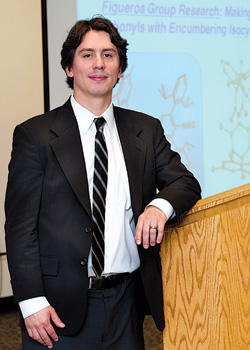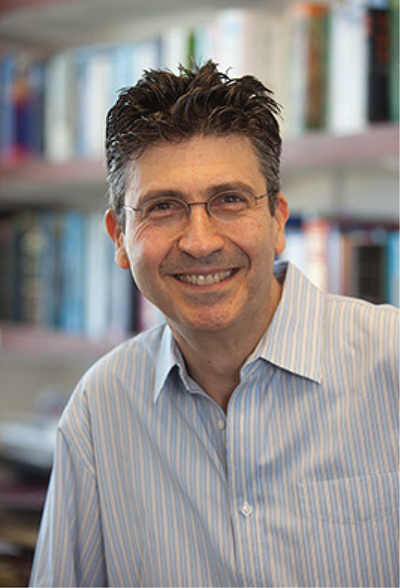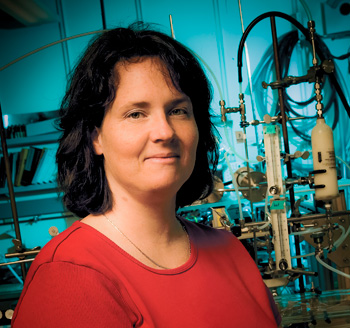Biochemistry

Prof. Elizabeth A. Komives
A student will take part in investigations on the protein-protein interaction of NFkB with IkBs, preparing one or more mutants were negatively charged residues in the PEST sequence are replaced with neutral side chain. Students will perform protein expression, purification, and binding kinetic studies (using SPR and stopped-flow fluorescence) to see whether the mutation affects NFkB binding. In addition, the PEST plays a critical role in repelling the DNA when IkBa “strips” NFkB off the DNA, and the kinetics of this process will also be studied.
Komives's group web site
http://komiveslab.ucsd.edu/Inorganic/Bioinorganic

Prof. Seth M. Cohen
A student will contribute to the synthesis and characterization of metal-organic frameworks (using X-ray powder diffraction and crystallography, NMR spectroscopy, mass spectrometry, and gas adsorption) within the context of developing new materials for renewable energy.
Cohen's group web site
http://cohenlab.ucsd.edu/
Prof. Joshua S. Figueroa
A student will engage in the synthesis, characterization and computational elucidation of new, organometallic manganese isocyanide complexes for the electrocatalytic reduction of carbon dioxide (CO2) to liquid fuels. This project is an integral part of a broader program focused on the use of earth-abundant metal isocyanide complexes in alternative energy production and the discovery of new chemical transformations.
Figueroa's group web site
http://figueroagroup.ucsd.edu/Organic/Bioorganic

Prof. Michael D. Burkart
A student will participate in the chemo-enzymatic synthesis of functionalized acyl carrier protein (ACP) from the E. coli biosynthetic pathway. This research involves protein expression and purification, small molecule organic synthesis, and bioconjugate synthesis and analysis. The modified proteins will be studied within the context of a larger project investigating the structure and protein-protein interactions of carrier protein dependent natural product biosynthetic pathways.
Burkart’s group web site
http://burkartlab.ucsd.edu/
Prof. Nathan C. Gianneschi
A student will be tasked with the preparation of peptide-nucleic acids for incorporation into polymeric nanostructures via direct polymerization, as novel monomers. These materials will constitute a unique approach to imposing biochemical information on synthetic polymeric systems. This project will be part of a larger program investigating new methods for programming materials to respond to specific biological signals and for utilization as nucleic acid and drug delivery vehicles.
Gianneschi's group web site
http://gianneschigroup.ucsd.edu/
Prof. Yitzhak Tor
A student will synthesize fluorescent nucleoside analogs and explore their photophysical properties. This project is part of a larger program focusing on the chemical biology of nucleic acids. It provides a multidisciplinary education and training ground for students and fellows, with emphasis on biophysical techniques that illuminate the stability, folding, recognition features and biological activity of biopolymers.
Tor's group web site
http://torgroup.ucsd.edu/Physical/Environmental

Prof. Judy E. Kim
A student will participate in efforts to elucidate general mechanisms of in vitro protein insertion and folding into bilayers, and to identify key proton and electron transfer pathways that enable long-range, multi-step charge separation in proteins. These physical chemistry projects will include time-resolved and steady-state electronic, vibrational, and magnetic spectroscopy to probe the photophysics, structures, and photochemistry of model protein and peptide systems, and exposure to molecular biology tools for protein expression and purification.
Kim's group web site
http://galileo.ucsd.edu/
Prof. Kimberly Prather
A student will work on heterogeneous reactions on sea spray aerosols in an effort to better understand ocean impacts on clouds and climate. Exposure to laser-based mass spectrometry, Raman spectroscopy, and AFM as well as other surface sensitive analytical techniques will be provided. The student will also obtain unique training in characterizing chemically complex samples and developing basic problem solving strategies.
Prather's group web site
http://atofms.ucsd.edu/
Prof. Mark H. Thiemens
A student will contribute to the development and use of ultra-high precision measurements of stable isotopes to delineate the fates of different atmospheric species in samples collected throughout the world, including the South Pole and tropical rainforests.
Thiemens's group web site
http://chem-faculty.ucsd.edu/thiemens/Theoretical

Prof. Rommie E. Amaro
A student will use computational biophysics to explore dynamic molecular recognition events in influenza virus host-cell entry, tackle drug discovery against targets in infectious diseases, apply multi-scale modeling to understand the regulation of protein kinase A from the molecular to the subcellular levels, or computational methods and tools development to advance these and other studies.